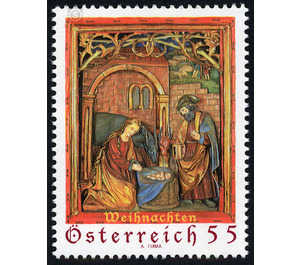Christmas - Austria / II. Republic of Austria 2007 - 55 Euro Cent
Theme: Architecture
| Country | Austria / II. Republic of Austria |
| Issue Date | 2007 |
| Face Value | 55.00 |
| Edition Issued | 8,000,000 |
| Printing Type | Photogravure |
| Stamp Type | Commemorative |
| Item Type | Stamp |
| Chronological Issue Number | 2029 |
| Chronological Chapter | OOS-OE2 |
| SID | 550640 |
| In 65 Wishlists | |
As a brand motif for the 2007 Christmas stamp, the depiction of the Nativity was selected on the altarpiece of the gothic winged altar of Oberwöllan. The precious altar dating back to 1519 is on loan to the Diocesan Museum in Klagenfurt after its renovation. The fully preserved altar presents itself as a true gem of the museum. The central picture of this altar has been worked as a shrine relief and depicts the Christmas scene in painted and carved form. A young Maria kneels in adoration to the child. Josef stands with devotion and holds a lantern in his hand. Ox and donkey warm the little child with their breath. The golden arched opening in the background is part of a ruined architecture that symbolizes the ending of the Old Testament. Partially obscured by the carved ornamental tendril, one recognizes the scene of the Annunciation to the shepherds. The central altarpiece is surrounded on the outside by two movable shrine wings, on which reliefs of St. Catherine and St. Barbara are depicted. The Annunciation scene is painted on the back of the wings. On the two wings you can see St. Dorothea and St. Agnes. In the altarpiece rises above the carved angel's ring a painted in the style of the Danube School Epiphany. The branch church St. Peter and Paul of the scattered settlement Oberwöllans in the municipality of Arriach is located on the sunny slope of Wöllaner Nock at an altitude of about 1200 m. It is one of the most historically valuable Höhenkirchen in Carinthia. Built in the 14th century, the Romanesque core of the church was extended to late Gothic and Baroque periods. The mighty tower with loopholes reminds of its former function as a walled fortified church. On the outside walls of the church were frescoes - a Christophorus can still be seen. The interior design dates back to the 16th or 17th century. Particularly noteworthy is the unique in Carinthia Betgestühl with side folding armchairs and dated 1530 painted coffered ceiling. In the sanctuary are still frescoes of an unknown master from 1494. The church of Oberwöllan was first mentioned in 1615 as a branch church of meetings, supervised by the Protestants. Since the time of the Reformation, many Arriachers have professed Lutheran faith. This was also evident in the general refurbishment of the important cultural monument in 1985, when the citizens of the municipality invested a great deal of money and working time in the renovation of their church.


